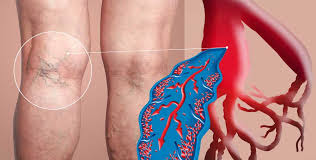Varicose vein disease (VVD) is a disorder that primarily affects the lower limbs of your legs, though it can also occasionally affect the upper or arms of your body. Vascular enlargement and fluid accumulation give the veins a thread-like appearance.
When veins join a muscle or bone, they often create a plexus around that location in patients with vein vein disease (VVD). Your leg muscles have difficulty moving as a result. Additionally, with time, they often become more fragile and feeble.
Causes of Varicose veins
Many factors contribute to the disease known as varicose veins. A few prevalent ones include genetics, family history, smoking, drinking alcohol, being obese, high blood pressure, and not exercising. There are other risk factors as well, such as using medications that cause varicose veins (such as angiotensin inhibitors, diuretics, alpha-blockers, etc.), being overweight, having an inherited gene, not getting enough sleep, and consuming excessive amounts of salt. It's also well known that smoking lowers blood flow to the feet, which can lead to the development of varicose veins. After having an operation, spinal fusion, or amputation, among other medical procedures, you may develop varicose veins.
Investigations
When it comes to treating someone with VVD, there are several options. After examining your specific case, your physician will suggest the best course of action. The following are a few methods you may try to treat your varicose veins:
Medical Treatments.
You must get assistance from a healthcare professional if your VVD is severe and requires emergency medical attention. Your doctor may recommend any number of treatments to reduce your pain and enhance your quality of life. Physical therapy, medication, or surgical procedures such as variceal bypass, ligation, balloon dilatation, or minimally invasive percutaneous transluminal angioplasty (PTA) may be among them. The main objective of treatment, which may differ based on the severity of your VVD, is to reduce swelling and improve your overall quality of life.
Physical Therapy.
Physical therapy can be used to assist you with relieving your discomfort and improving your overall health. It involves stretching exercises, strengthening exercises, massage, and elevation. Also, you can have your legs massaged or even given traction to relieve any muscle tension that may be causing you discomfort. Many patients find that physiotherapy helps them to feel better within a few days of starting treatment.
Medications.
To treat varicose veins, prescription drugs are frequently given. For instance, sclerotherapy—which stands for "scleroderma"—may be recommended to you if the damage to your varicose veins is irreversible. A tiny amount of liquid or gel is injected into the veins during sclerosing therapy, and it is then allowed to gradually drain out until the skin around the veins becomes flaky and dry, making the veins easier to pass through. Another drug called nitroglycerine, which dilates the veins in a procedure known as venous stasis reduction, may be prescribed for this condition. It is possible to give nitroglycerine intravenously or via a port.
Surgical Procedures.
When other treatments fail, surgery might be suggested, but it can only be performed if it is intended specifically for VVD. To minimise swelling, a varicose vein (the vein above the kneecap) can be removed during an open variceal ligation (OLV) procedure for VVD. By stopping the vein from contracting any further, ligation promotes vein expansion. Usually, general anaesthesia is used during the procedure. One of the two methods frequently used to treat adult varicose veins is open variceal ligation.
If the varices are big enough to create blockages, additional treatments
might involve cutting them open, or phlebectomies. When children with
variceal bleeding have VVD, plebectomy is frequently used as a
treatment. There is never a guarantee that varicose veins will heal
after surgery, so it is always best to consult a healthcare provider
before attempting any surgery.










Thumbs up
ReplyDelete